Tribological Behavior and Wear Protection Ability of Graphene Additives in Synthetic Hydrocarbon Base Stocks
Abstract
1. Introduction
2. Materials and Methods
2.1. Materials
2.2. Preparation of Oils
2.3. Characterization
2.4. Tribological Tests
3. Results and Discussion
3.1. Characterization of Graphene Additives
3.2. Stability Monitoring of the Prepared Oils
3.3. Tribological Performance
3.3.1. Tribological Performance of Graphene Additives at Different Additions
3.3.2. Tribological Performance of Graphene Additives under Different Test Loads
3.3.3. Tribological Performance of Graphene Additives at Different Test Temperatures
3.3.4. Tribological Performances of Graphene Additives in Different Base Stocks
3.3.5. The Lubrication Mechanism
4. Conclusions
Author Contributions
Funding
Conflicts of Interest
References
- Pournorouz, Z.; Mostafavi, A.; Pinto, A.; Bokka, A.; Jeon, J.; Shin, D. Enhanced thermophysical properties via PAO superstructure. Nanoscale Res. Lett. 2017, 12, 29. [Google Scholar] [CrossRef] [PubMed]
- Nifant’ev, I.; Bagrov, V.; Vinogradov, A.; Vinogradov, A.; Ilyin, S.; Sevostyanova, N.; Batashev, S.; Ivchenko, P. Methylenealkane-Based Low-Viscosity Ester Oils: Synthesis and Outlook. Lubricants 2020, 8, 50. [Google Scholar] [CrossRef]
- Dong, S.Q.; Mi, P.K.; Xu, S.; Zhang, J.; Zhao, R.D. Preparation and Characterization of Single-Component Poly-α-olefin Oil Base Stocks. Energy Fuels 2019, 33, 9796–9804. [Google Scholar] [CrossRef]
- Kong, S.; Wang, J.; Hu, W.; Li, J. Effects of Thickness and Particle Size on Tribological Properties of Graphene as Lubricant Additive. Tribol. Lett. 2020, 68, 112. [Google Scholar] [CrossRef]
- Yu, Q.; Zhang, C.; Dong, R.; Shi, Y.; Wang, Y.; Bai, Y.; Zhang, J.; Cai, M.; Zhou, F.; Novel, N. P-containing oil-soluble ionic liquids with excellent tribological and anticorrosion performance. Tribol. Int. 2018, 132, 118–129. [Google Scholar] [CrossRef]
- Pogorielov, M.; Smyrnova, K.; Kyrylenko, S.; Gogotsi, O.; Zahorodna, V.; Pogrebnjak, A. MXenes—A new class of two-dimensional materials: Structure, properties and potential applications. Nanomaterials 2021, 11, 3412. [Google Scholar] [CrossRef]
- Rakhadilov, B.K.; Maksakova, O.V.; Buitkenov, D.B.; Kylyshkanov, M.K.; Pogrebnjak, A.D.; Antypenko, V.P.; Konoplianchenko, Y.V. Structural-phase and tribo-corrosion properties of composite Ti3SiC2/TiC MAX-phase coatings: An experimental approach to strengthening by thermal annealing. Appl. Phys. A 2022, 128, 145. [Google Scholar] [CrossRef]
- Liu, T.; Qin, J.; Wang, J.; Li, J. On the Tribological Properties of RGO–MoS2 Composites Surface Modified by Oleic Acid. Tribol. Lett. 2022, 70, 14. [Google Scholar] [CrossRef]
- Xu, Z.; Lou, W.; Wu, X.; Wang, X.; Hao, J. Investigating the tribological behavior of PEGylated MoS2 nanocomposites as additives in polyalkylene glycol at elevated temperature. RSC Adv. 2017, 7, 53346–53354. [Google Scholar] [CrossRef]
- Ratoi, M.; Niste, V.B.; Zekonyte, J. WS2 nanoparticles-potential replacement for ZDDP and friction modifier additives. RSC Adv. 2014, 4, 21238–21245. [Google Scholar] [CrossRef]
- Berman, D.; Erdemir, A.; Sumant, A.V. Graphene: A new emerging lubricant. Mater. Today 2014, 17, 31–42. [Google Scholar] [CrossRef]
- Omrani, E.; Menezes, P.L.; Rohatgi, P.K. Effect of Micro-and Nano-Sized Carbonous Solid Lubricants as Oil Additives in Nanofluid on Tribological Properties. Lubricants 2019, 7, 25. [Google Scholar] [CrossRef]
- Pape, F.; Poll, G. Investigations on Graphene Platelets as Dry Lubricant and as Grease Additive for Sliding Contacts and Rolling Bearing Application. Lubricants 2019, 8, 3. [Google Scholar] [CrossRef]
- Wu, Q.; Li, H.; Wu, L.; Bo, Z.; Wang, C.; Cheng, L.; Wang, C.; Peng, C.; Li, C.; Hu, X.; et al. Synergistic Lubrication and Antioxidation Efficacies of Graphene Oxide and Fullerenol as Biological Lubricant Additives for Artificial Joints. Lubricants 2022, 11, 11. [Google Scholar] [CrossRef]
- Liu, Y.; Yu, S.; Shi, Q.; Ge, X.; Wang, W. Graphene-family lubricant additives: Recent developments and future perspectives. Lubricants 2022, 10, 215. [Google Scholar] [CrossRef]
- Kim, K.-S.; Lee, H.-J.; Lee, C.; Lee, S.-K.; Jang, H.; Ahn, J.-H.; Kim, J.-H.; Lee, H.-J. Chemical Vapor Deposition-Grown Graphene: The Thinnest Solid Lubricant. ACS Nano 2011, 5, 5107–5114. [Google Scholar] [CrossRef]
- Zhang, W.; Zhou, M.; Zhu, H.; Yu, T.; Wang, K.; Wei, J.; Ji, F.; Li, X.; Li, Z.; Zhang, P.; et al. Tribological properties of oleic acid-modified graphene as lubricant oil additives. J. Phys. D Appl. Phys. 2011, 44, 225303. [Google Scholar] [CrossRef]
- Yin, S.; Wu, H.; Yi, X.; Huang, Z.; Ye, C.; Li, P.; Zhang, Y.; Shi, J.; Hua, K.; Wang, H. Enhanced graphene oxide adhesion on steel surface through boronizing functionalization treatment: Toward the robust ultralow friction. Carbon 2023, 206, 201–210. [Google Scholar] [CrossRef]
- Ismail, N.A.; Bagheri, S. Highly oil-dispersed functionalized reduced graphene oxide nanosheets as lube oil friction modifier. Mater. Sci. Eng. B 2017, 222, 34–42. [Google Scholar] [CrossRef]
- Shi, J.; Yi, X.; Wang, J.; Jin, G.; Lu, Y.; Wu, H.; Fan, X. Carbonaceous soot dispersion characteristic and mechanism in lubricant with effect of dispersants by molecular dynamics simulation and experimental studies. Carbon 2022, 200, 253–263. [Google Scholar] [CrossRef]
- Nair, R.R.; Ren, W.; Jalil, R.; Riaz, I.; Kravets, V.G.; Britnell, L.; Blake, P.; Schedin, F.; Mayorov, A.S.; Yuan, S.; et al. Fluorographene: A two-dimensional counterpart of Teflon. Small 2010, 6, 2877–2884. [Google Scholar] [CrossRef]
- Matsumura, K.; Chiashi, S.; Maruyama, S.; Choi, J. Macroscale tribological properties of fluorinated graphene. Appl. Surf. Sci. 2018, 432, 190–195. [Google Scholar] [CrossRef]
- Fan, K.; Chen, X.; Wang, X.; Liu, X.; Liu, Y.; Lai, W.; Liu, X. Toward excellent tribological performance as oil-based lubricant additive: Particular tribological behavior of fluorinated graphene. ACS Appl. Mater. Interfaces 2018, 10, 28828–28838. [Google Scholar] [CrossRef]
- Fan, K.; Liu, J.; Wang, X.; Liu, Y.; Lai, W.; Gao, S.; Qin, J.; Liu, X. Towards enhanced tribological performance as water-based lubricant additive: Selective fluorination of graphene oxide at mild temperature. J. Colloid Interface Sci. 2018, 531, 138–147. [Google Scholar] [CrossRef] [PubMed]
- Ma, L.; Li, Z.; Jia, W.; Hou, K.; Wang, J.; Yang, S. Microwave-assisted synthesis of hydroxyl modified fluorinated graphene with high fluorine content and its high load-bearing capacity as water lubricant additive for ceramic/steel contact. Colloids Surf. A Physicochem. Eng. Asp. 2021, 610, 125931. [Google Scholar] [CrossRef]
- Meloni, D.; Monaci, R.; Solinas, V.; Auroux, A.; Dumitriu, E. Characterization of the active sites in mixed oxides derived from LDH precursors by physico-chemical and catalytic techniques. Appl. Catal. A Gen. 2008, 350, 86–95. [Google Scholar] [CrossRef]
- Wang, X.; Wang, W.; Xu, D.; Liu, Y.; Lai, W.; Liu, X. Activation effect of porous structure on fluorination of graphene based materials with large specific surface area at mild condition. Carbon 2017, 124, 288–295. [Google Scholar] [CrossRef]
- Boopathi, S.; Narayanan, T.N.; Kumar, S.S. Improved heterogeneous electron transfer kinetics of fluorinated graphene derivatives. Nanoscale 2014, 6, 10140–10146. [Google Scholar] [CrossRef] [PubMed]
- Lu, A.-H.; Hao, G.-P.; Sun, Q. Can Carbon Spheres Be Created through the Stober Method? Angew. Chem.-Int. Ed. 2011, 50, 9023–9025. [Google Scholar] [CrossRef]
- Bon, S.B.; Valentini, L.; Verdejo, R.; Garcia Fierro, J.L.; Peponi, L.; Lopez-Manchado, M.A.; Kenny, J.M. Plasma Fluorination of Chemically Derived Graphene Sheets and Subsequent Modification with Butylamine. Chem. Mater. 2009, 21, 3433–3438. [Google Scholar] [CrossRef]
- Tuinstra, F.; Koenig, J.L. Raman Spectrum of Graphite. J. Chem. Phys. 1970, 53, 1126–1130. [Google Scholar] [CrossRef]
- Yang, H.; Li, J.; Zeng, X. Correlation between Molecular Structure and Interfacial Properties of Edge or Basal Plane Modified Graphene Oxide. ACS Appl. Nano Mater. 2019, 1, 2763–2773. [Google Scholar] [CrossRef]
- Fan, K.; Fu, J.; Liu, X.; Liu, Y.; Lai, W.; Liu, X.; Wang, X. Dependence of the fluorination intercalation of graphene toward high-quality fluorinated graphene formation. Chem. Sci. 2019, 10, 5546–5555. [Google Scholar] [CrossRef]
- Ci, X.; Zhao, W.; Luo, J.; Wu, Y.; Ge, T.; Xue, Q.; Gao, X.; Fang, Z. How the fluorographene replaced graphene as nanoadditive for improving tribological performances of GTL-8 based lubricant oil. Friction 2020, 9, 488–501. [Google Scholar] [CrossRef]
- Quan, Y.; Liu, Q.; Li, K.; Zhang, H.; Yang, Y.; Zhang, J. Simultaneous fluorination and purification of natural block coaly graphite into fluorinated graphene with tunable fluorination degree. Mater. Today Commun. 2022, 32, 104130. [Google Scholar] [CrossRef]
- Zhang, X.; Yu, L.; Wu, X.; Hu, W. Experimental Sensing and Density Functional Theory Study of H2S and SOF2 Adsorption on Au-Modified Graphene. Adv. Sci. 2015, 2, 1500101. [Google Scholar] [CrossRef] [PubMed]
- Sun, C.; Feng, Y.; Li, Y.; Qin, C.; Zhang, Q.; Feng, W. Solvothermally exfoliated fluorographene for high-performance lithium primary batteries. Nanoscale 2014, 6, 2634–2641. [Google Scholar] [CrossRef]
- Lu, X.; Khonsari, M.; Gelinck, E. The Stribeck curve: Experimental results and theoretical prediction. J. Tribol. 2006, 128, 789–794. [Google Scholar] [CrossRef]
- Archard, J.F. Contact and Rubbing of Flat Surfaces. J. Appl. Phys. 1953, 24, 981–988. [Google Scholar] [CrossRef]
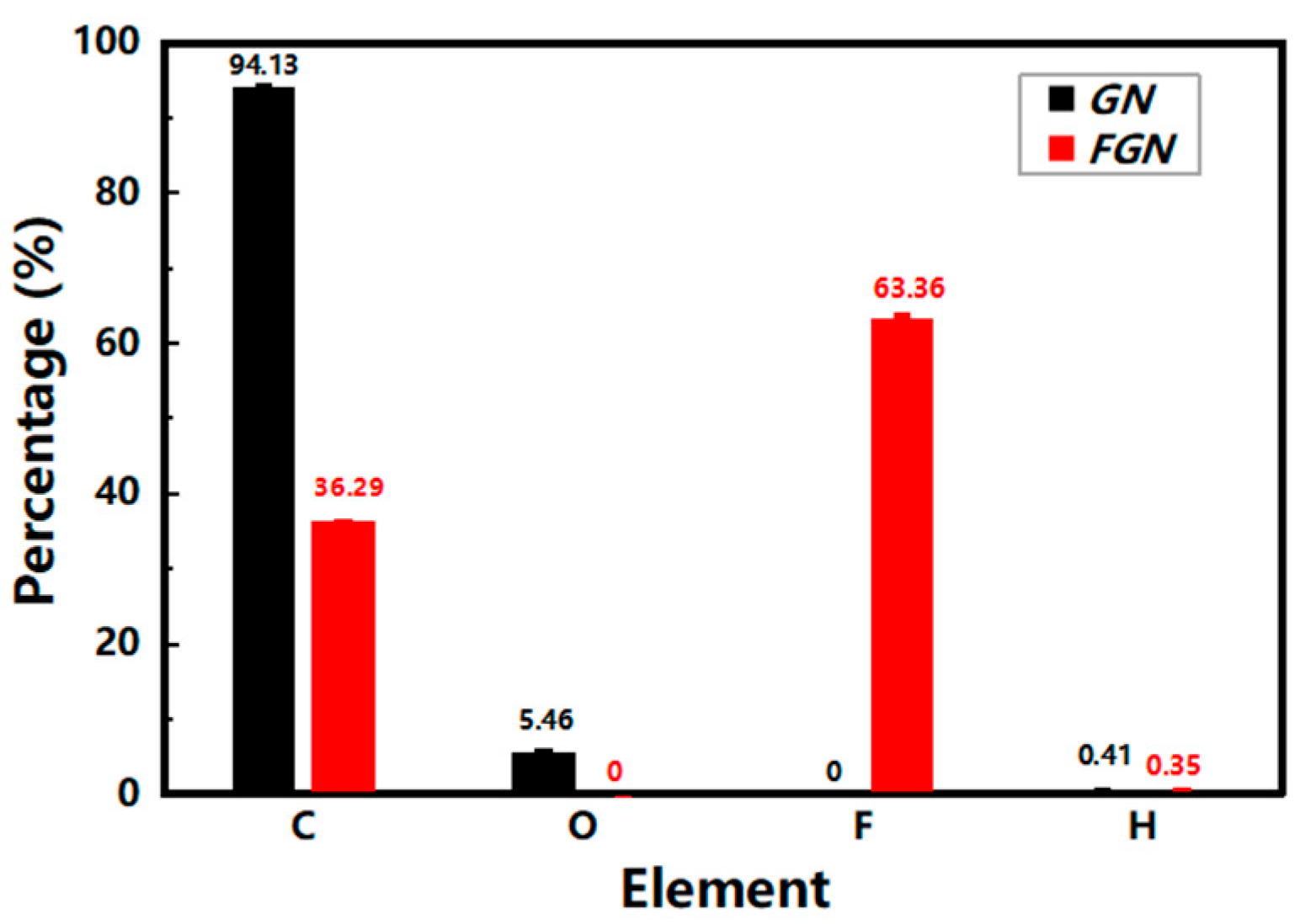
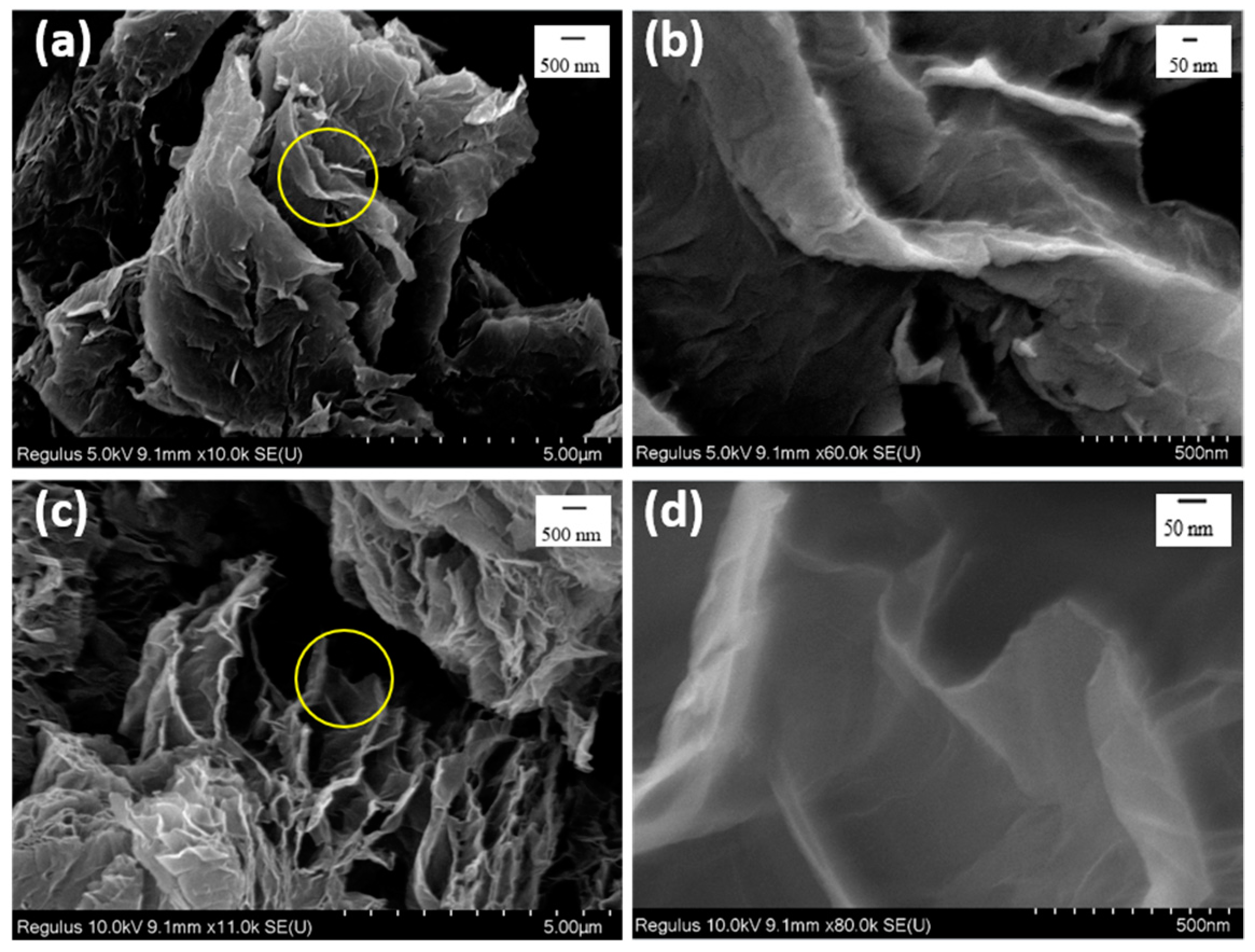
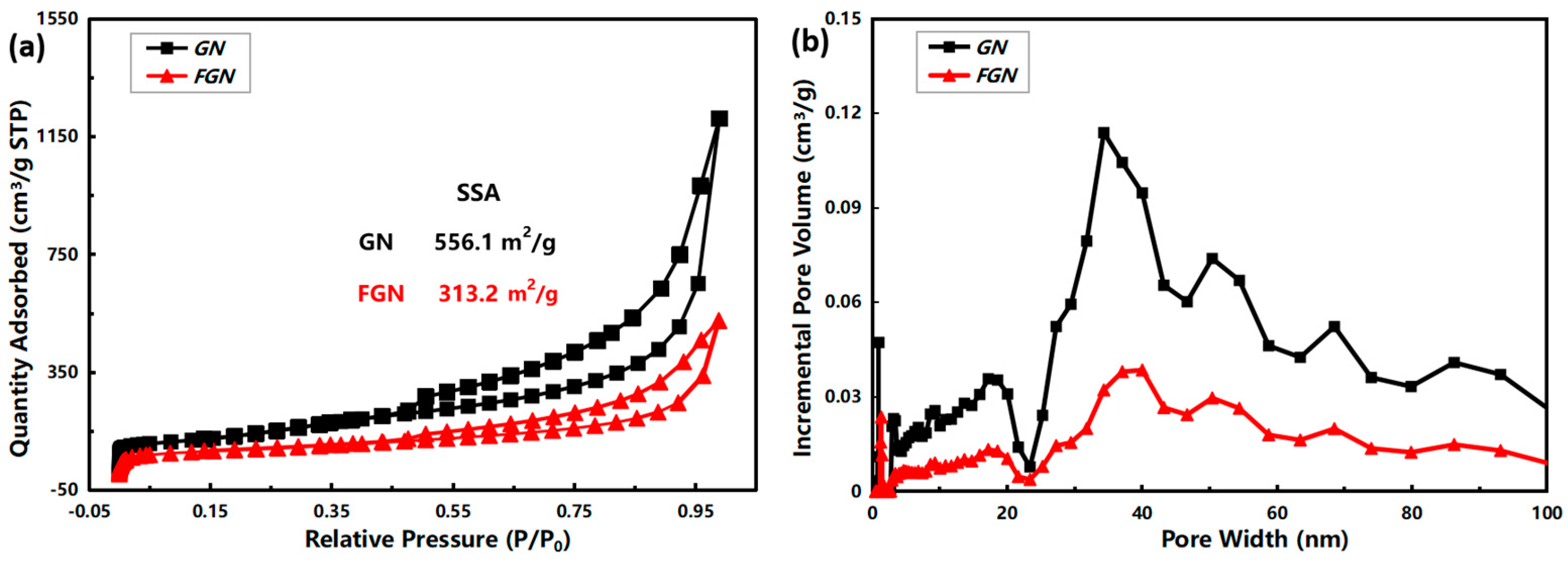
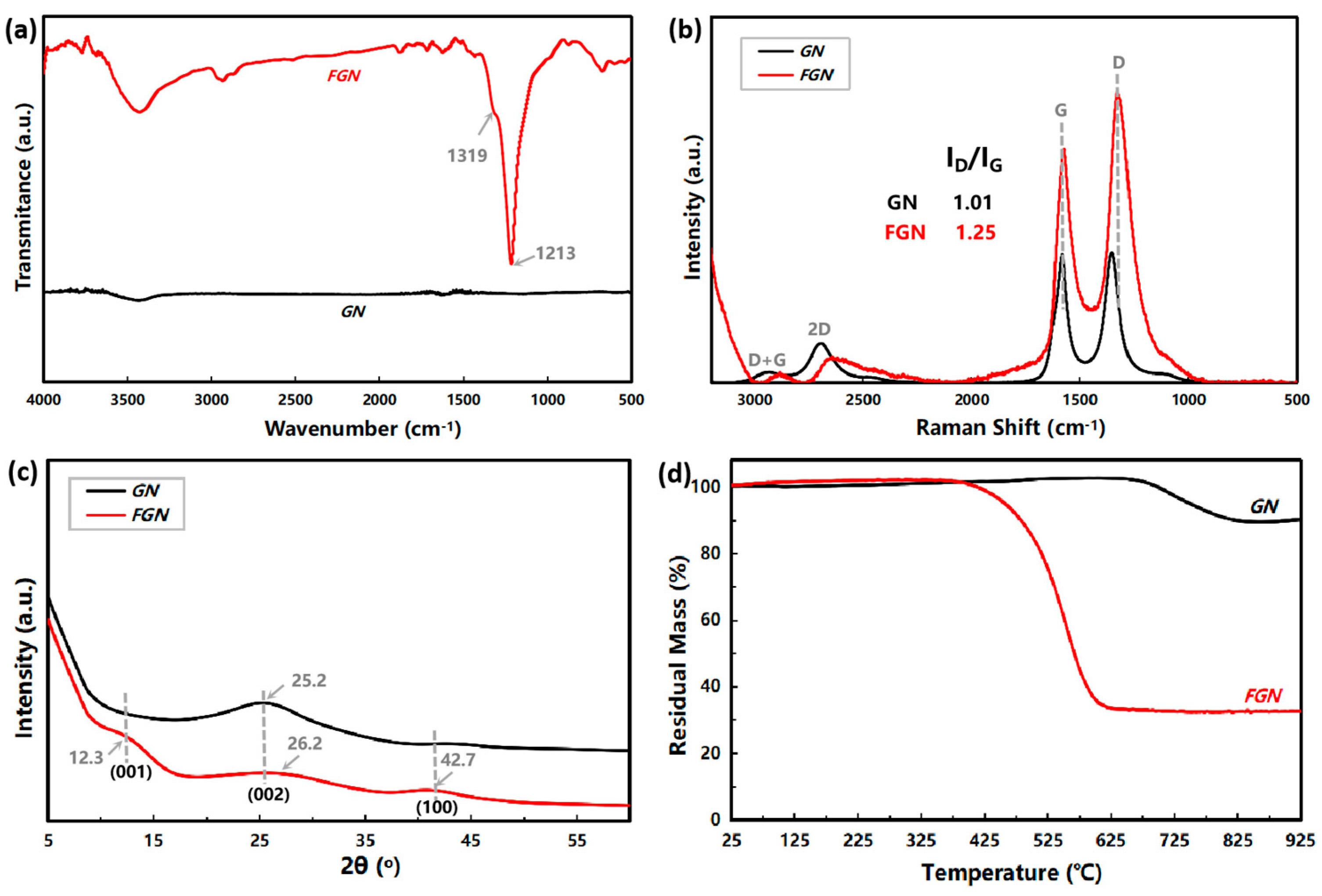
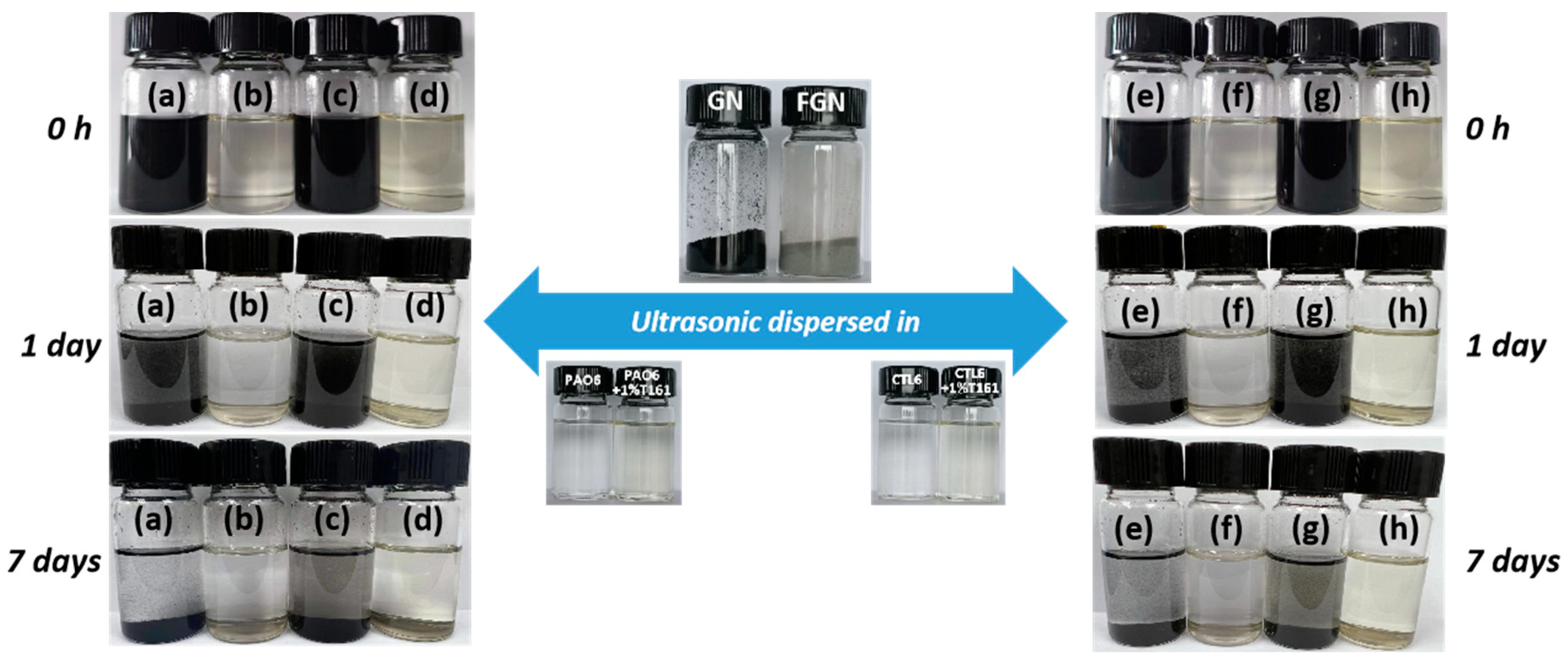
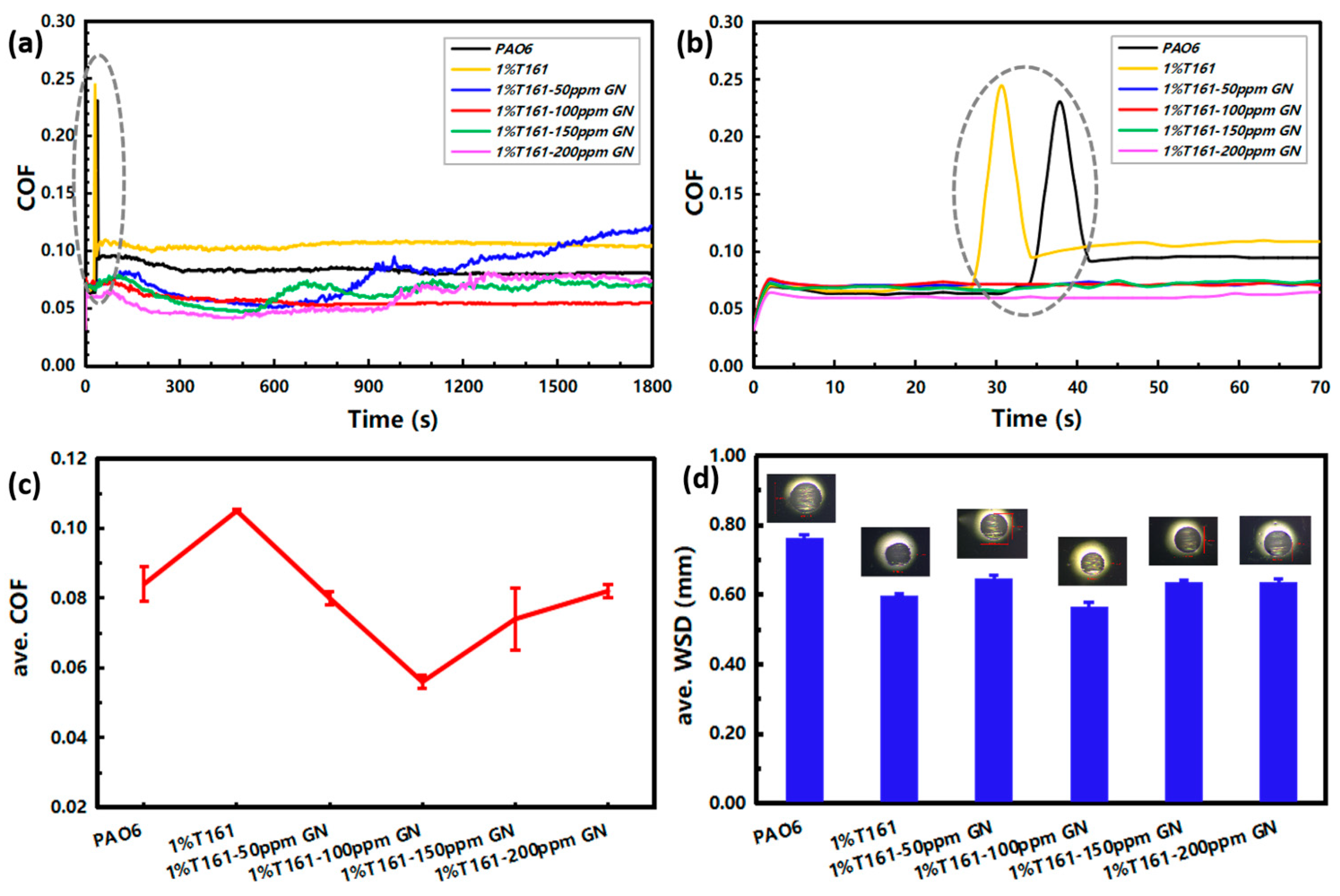
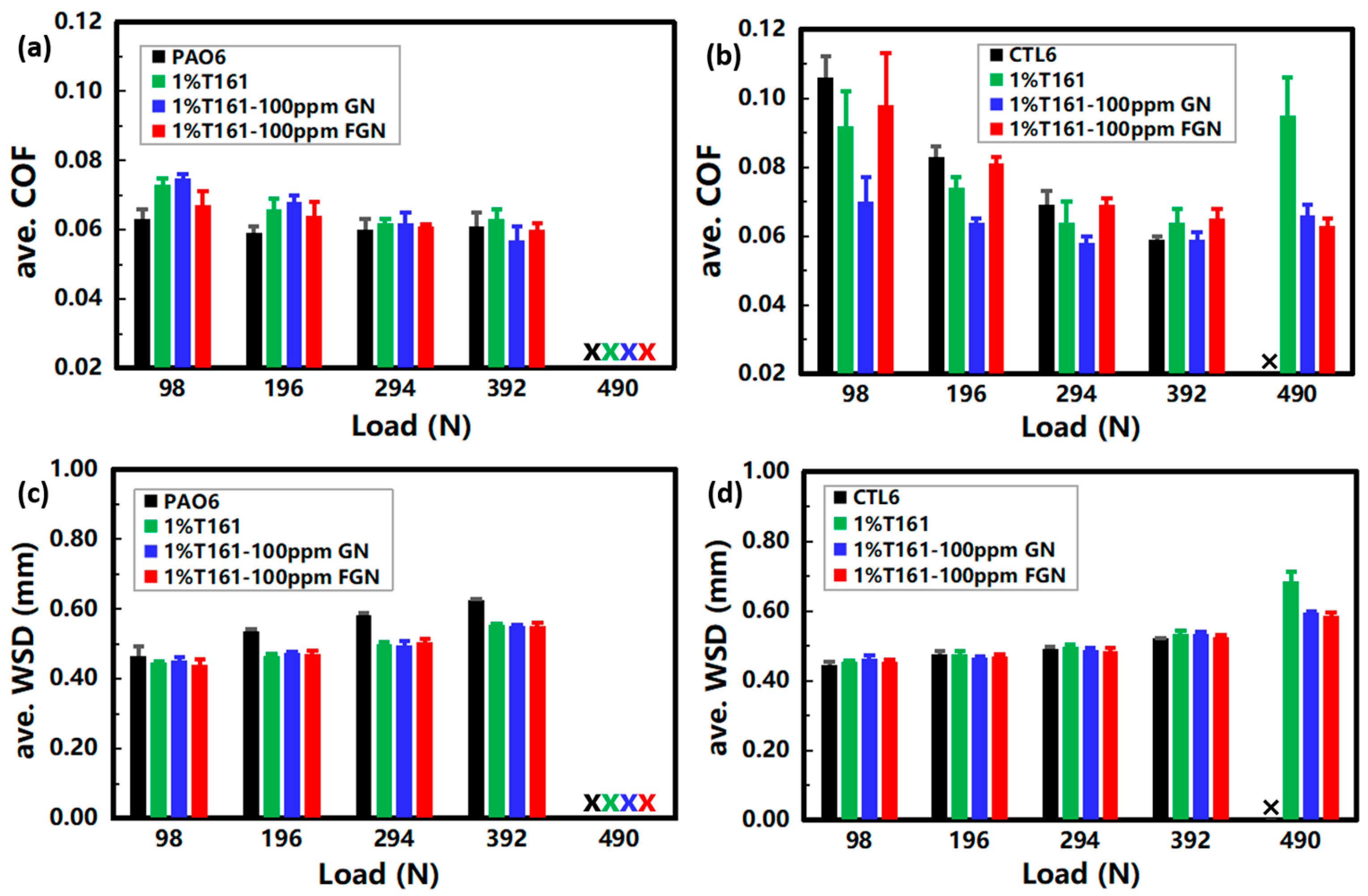

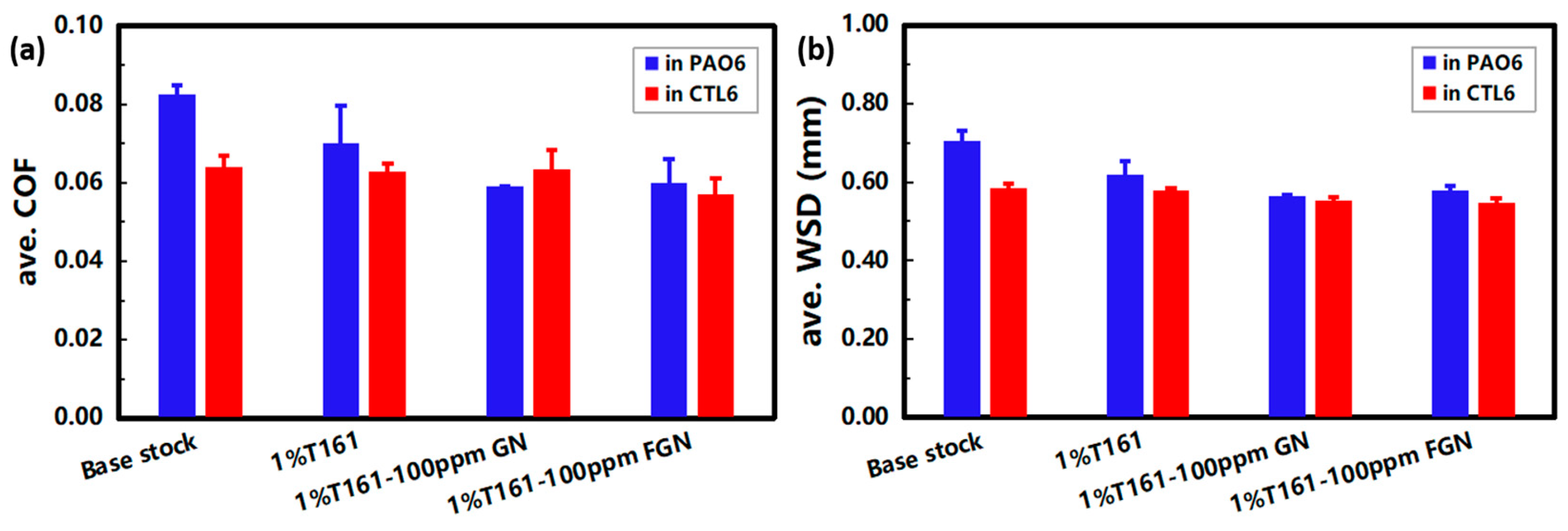

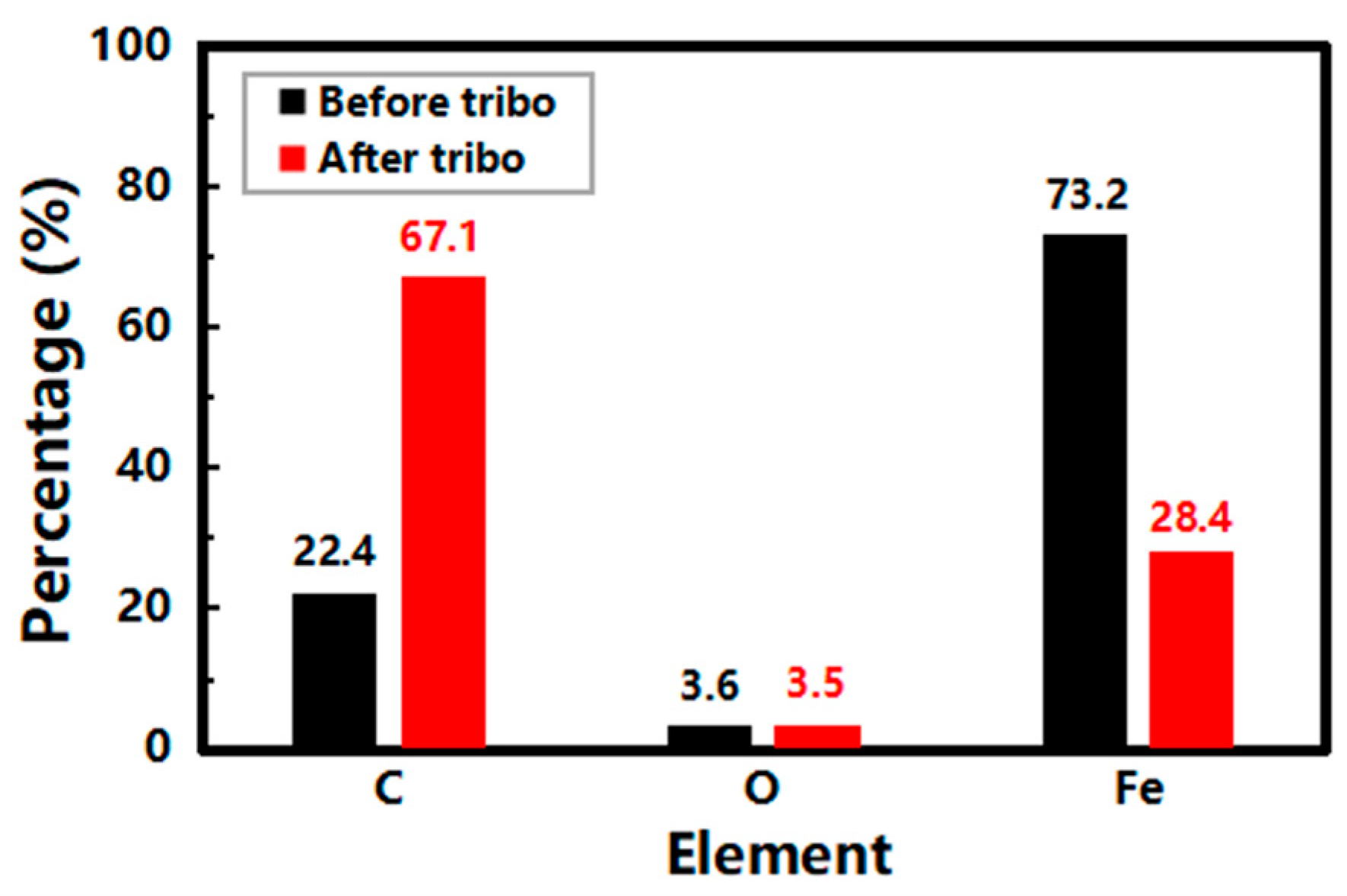
| Initial Weight Loss Temperature (Ti), °C | Maximum Weight Loss Temperature (Tmax), °C | Weight Loss at Tmax, % | |
|---|---|---|---|
| GN | 547 | 721 | 10.5 |
| FGN | 347 | 551 | 68.5 |
Disclaimer/Publisher’s Note: The statements, opinions and data contained in all publications are solely those of the individual author(s) and contributor(s) and not of MDPI and/or the editor(s). MDPI and/or the editor(s) disclaim responsibility for any injury to people or property resulting from any ideas, methods, instructions or products referred to in the content. |
© 2023 by the authors. Licensee MDPI, Basel, Switzerland. This article is an open access article distributed under the terms and conditions of the Creative Commons Attribution (CC BY) license (https://creativecommons.org/licenses/by/4.0/).
Share and Cite
Du, G.; Yang, H.; Sun, X.; Tang, Y. Tribological Behavior and Wear Protection Ability of Graphene Additives in Synthetic Hydrocarbon Base Stocks. Lubricants 2023, 11, 200. https://doi.org/10.3390/lubricants11050200
Du G, Yang H, Sun X, Tang Y. Tribological Behavior and Wear Protection Ability of Graphene Additives in Synthetic Hydrocarbon Base Stocks. Lubricants. 2023; 11(5):200. https://doi.org/10.3390/lubricants11050200
Chicago/Turabian StyleDu, Ge, Hongmei Yang, Xiuli Sun, and Yong Tang. 2023. "Tribological Behavior and Wear Protection Ability of Graphene Additives in Synthetic Hydrocarbon Base Stocks" Lubricants 11, no. 5: 200. https://doi.org/10.3390/lubricants11050200
APA StyleDu, G., Yang, H., Sun, X., & Tang, Y. (2023). Tribological Behavior and Wear Protection Ability of Graphene Additives in Synthetic Hydrocarbon Base Stocks. Lubricants, 11(5), 200. https://doi.org/10.3390/lubricants11050200






